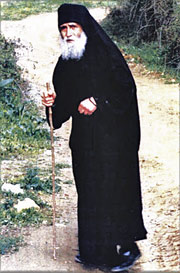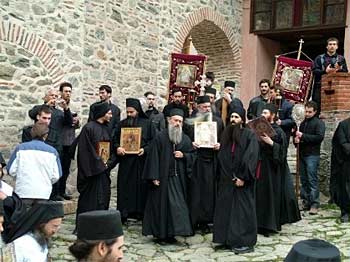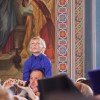|
 As it reached the end of its first millennium in 1963, the monastic republic As it reached the end of its first millennium in 1963, the monastic republic
of Mount Athos seemed to have completed its life cycle and to be breathing its
last. It had been born, grown to maturity, produced a rich harvest of fruit, and
grown old. Its strength was shockingly reduced. The numbers of the monks had
fallen considerably and their average age was now over fifty-five. The elders
were dying naturally, without seeing younger men come to take their place in the
monasteries and hermitages. Huge monastic complexes that had once pulsated with
life now stood derelict and deserted. Everything betokened decline and decay.
Certainly, this was not the first decline the monastic republic had experienced
in its long history. Yet almost everyone believed it would be the last. Many of
the monks, even, had come to believe that they would have no successors. And so,
on the fringes of the millennial celebrations, it was being said that the
festivities were in fact the ‘funeral service’ or even the ‘requiem’ for
Athonite monasticism.
The first decade of the second millennium gave
every indication of confirming the gloomy prognostications. The monks’ numbers
continued to dwindle, the signs of depopulation were unmistakable, and the
future looked bleak indeed. What was more, the notion began to glimmer in the
minds of some of those responsible, and of others less responsible, that efforts
should be made to exploit the inestimable treasures of this thousand-year-old
republic as tourist attractions. But the prospects in this direction were not
promising. Special studies showed that the cost of bringing tourists to Mount
Athos and possibly of replacing the monks with custodians to look after and
protect the treasures would be considerably greater than the anticipated
revenue.
 While all this was going on, a curious change started to take While all this was going on, a curious change started to take
place on Mount Athos, ‘the Garden of the Virgin’, as the monks like to call it.
It was a change which not even the most sanguine objective view could have
foreseen, a change which vindicated the naive and simple hopes of those Athonite
monks who had always insisted that the Virgin would never allow her garden to be
deserted.
A rough head count carried out at the end of that first decade after the ‘funeral
service’ produced an important indication, which attracted our close attention.
In recent decades, the statistics had shown that the number of monks on Mount
Athos was steadily falling; but in 1972, for the first time, the data showed
that the number had not fallen but had in fact risen over the previous year, by
one. There had been 1,145 monks on Athos in 1971; in 1972 there were 1,146.
Apparently negligible then, but in fact highly significant, the increase
has continued right up to the present day. The occasional down-turn in the
generally upward trend has been due to the high mortality rate in the older
monastic population. Thus, from 1972 to 1996, when the last census was taken,
1,036 new monks came to Mount Athos. More specifically, in the first five years
(1972-6), 143 new monks arrived, averaging out at about 29 a year. Between 1977
and 1986, 284 new monks came, with the same average annual rate. And the decade
1987-96 saw the arrival of 609 new monks, an average of about 61 a year. So it
is clear that the influx of new monks has not merely been sustained, it has in
fact increased by more than 100% in the last ten years.
The increase in
the number of monks was not evenly distributed among all the monasteries. Until
the mid-1970s, only eight of the twenty monasteries saw an increase in their
population, while the numbers continued to fall in the other twelve. The eight
were: Iviron, Chelandari, Karakalou, Philotheou, Simonopetra, St Paul’s,
Gregoriou, and Esphigmenou. Three of these (Philotheou, Simonopetra, and
Gregoriou) showed a striking increase, which in the case of Simonopetra actually
tripled the number of monks. This was because they did not arrive singly, but in
groups known as synodeies, chiefly made up of young men from monasteries outside
Athos, who had been invited by the remaining incumbents, alarmed by the
relentless depopulation of their monasteries. In most cases, it was necessary to
by-pass a number of formalities for the newcomers to take up permanent
residence. Thus, a monastery which, having consulted the Holy Community, invited
a group of monks, was contravening article 112 of the Charter, with regard to
the age of the group’s spiritual father or the place where he had been tonsured,
in permitting him to live on Athos and to become a hegumen.
In the
initial period of the resurgence of monasticism on Mount Athos, there was a
tendency for synodeies to move en bloc from dependencies, which contained about
three fifths of the Athonite population, to monasteries. However, owing to the
ramshackle state of the monasteries, the lone individuals arriving to take up
the monastic life did not stay in the monasteries, but preferred the sketae and
hermitages, where they lived an ascetic life and exerted a considerable
spiritual influence. It was in the 1950s that the synodeia of Father Joseph
Spelaiotis started to come together, followed in the 1960s by that of Father
Padsios.
The growing membership of the new synodeies, which brought with
it an increased need for housing, made it difficult for them to continue in the
dependencies. The need to seek more suitable accommodation became pressing; and
this accommodation was now available in the monasteries, which were gradually
falling empty and offered ample space to meet the growing needs of the
synodeies. So flourishing synodeies were now invited to move into the
depopulated monasteries. The new arrivals gradually took over the administration
of the monasteries in which they settled, and made them suitable not only for
their own occupation but also to receive new monks.
In the second stage,
from the mid-1970s onwards, monks began to move, again in groups, from the more
flourishing monasteries to the weaker ones. Again the new arrivals took over the
administration and running of their new abode; and thus was avoided a
disproportionate increase in the population of some monasteries and the total
depopulation of others.
Early in the 1980s, there began a gradual
movement from the monasteries back to the dependencies. Monks who had lived in
the monasteries for some years and acquired the necessary monastic experience
withdrew to dependencies, where there was more peace and quiet. And thus began
the broader revival of the hesychasteria.
The number of monks on Mount
Athos is rising in inverse proportion to their average age, because almost all
the recent arrivals are young men. Already the vast majority of Athonite monks
have arrived within the past twenty-five years. This has had a rejuvenating
effect on Athonite monasticism and fully re-established the age pyramid,
reducing the average age to about forty-eight. Most of the monks today are aged
between thirty-one and forty, and there are more and younger monks in the
monasteries than in the dependencies.
Furthermore, their level of
education is appreciably higher than the average in the Greek population as a
whole. Many of the novices have completed further or higher education and hold
qualifications in a variety of disciplines. In the five-year period 1960-4, for
instance, only three holders of university degrees took up residence on Mount
Athos (2.8%), whereas today there are 343 monks (27%) with university degrees.
Of these, 133 (10.5%) have degrees in Theology, and 210 (16.5%) degrees in other
subjects. Only 1.7% of the monks today have not completed primary education.
Regarding the organisation of monastic life on Mount Athos, there have
been some rapid developments during this recent period. It is the coenobitic
system, which rejects personal ownership of property, that is generally
acknowledged as the truest form of collective monastic life. The idiorrhythmic
system may be described as a development of the old lavran system: it has
prevailed at various crucial turning-points in the history of monasticism, and
permits personal ownership of property. All of the twenty sovereign monasteries
on Athos today have passed through an idiorrhythmic stage at some point in their
history. The Athonite Charter forbids a coenobitic house to become
idiorrhythmic, though an idiorrhythmic house may become coenobitic (article 85).
Twenty-five years ago, nine of the twenty monasteries were idiorrhythmic; today
they are all coenobia. All the other monastic foundations on Mount Athos
(sketae, kellia, kalyvae, hesychasteria, and kathismata) are under the
jurisdiction of one or another of the twenty sovereign monasteries, as are the
metochia outside Mount Athos, many of which are notable spiritual centres.
It is important to note that it is not only the traditionally Orthodox
countries (Greece, Russia, Romania, Bulgaria, Serbia, Georgia) that are
represented on Athos today: there are monks from many other parts of the world,
including Britain, France, Germany, Canada, the Netherlands, Peru, Syria, and
Africa. Athonite monasticism is thus truly ecumenical. It is vitally important
that this ecumenical aspect be preserved and strengthened, for the sake not only
of monasticism, but of the whole Church too.
The source of this
resurgence of Athonite monasticism may be traced to a number of powerful
charismatic figures who have exerted a strong spiritual and moral influence.
Some of them are still alive, others have died within our own time, but they all
created powerful currents that attracted many to the monastic life. Those who
have passed away include Joseph Spilaiotis (d.E1959), a hermit and elder who may
be regarded as the spiritual father of six of the twenty sovereign monasteries;
Father Padsios (d.E1994), who also played a part in the establishment or revival
of some of the monasteries, and was a spiritual guide for many Athonite monks
and countless other believers; and Father Sophronios (d.E1993), who, although he
spent the last decades of his life at the Monastery of St John the Baptist in
Essex, which he himself founded, lived on Mount Athos for more than twenty years
(1925-47) and, through his book St Silvan the Athonite, brought many young men
to the monastic life.
As far as the form of monastic life is concerned,
one notable feature of this early second millennium has been a certain coming
together of the coenobitic and the Hesychastic tradition. The Hesychastic
tradition with its continuous, internalised Jesus Prayer, which was cultivated
almost exclusively in the hesychasteria, has entered and spread through the
coenobia, and is now a fundamental aspect of coenobitic life. By the same token,
the regular church services of the coenobitic tradition, which were once unknown
in the Hesychastic tradition, have entered and become an established part of it.
Regular services now structure Hesychastic life in almost all the hesychasteria
on Athos.
This interpenetration of the Hesychastic and coenobitic
traditions has been accompanied by a certain broader rapprochement between
monasticism and the secular world. It was always a feature of the Orthodox
Church, but had flagged somewhat in modern times. The situation has now changed
completely. Thousands of visitors flock to Mount Athos every year and experience
for themselves the spirituality and the life of the monks. Similarly, through
public talks, periodicals, and special publications, by taking a stand on
serious ecclesiastical and social issues, and, even more, by offering individual
spiritual guidance, the monks are strongly influencing the spiritual life of the
Christian community and are making a substantial impact on the Church and
society. The re-animation of religious life and the great interest in Orthodox
spiritual life now being manifested both in Greece and in the Orthodox Christian
world as a whole are a direct result of this rapprochement between monasticism
and society in the secular world.
The Centre for the Preservation of
Athonite Heritage was founded in 1981. It involves representatives of the Holy
Community of Mount Athos, the Greek government, and the Secretary General of the
Ministry of Macedonia and Thrace, which is the civil body responsible for Mount
Athos. Among other things, the Centre handles the moneys allocated for projects
and works on Mount Athos.
Greece’s accession to the EU naturally posed
problems with regard to the very special way of life on the Holy Mountain. These
were resolved when Greece and the other member-states signed a common
declaration safeguarding the distinctive nature and the special legal status of
Mount Athos.
One gratifying activity that is now taking place on Athos –
though some people find it a matter of some concern – is feverish rebuilding.
The ruined and dilapidated monastery buildings are rapidly being restored, which
is proving to be a source of distraction and apprehension for the monks.
Furthermore, the large numbers of pilgrims and visitors – who turn up almost all
the year round –, machinery, and road vehicles, coupled with the present
road-building activities, are taking a toll on the way and the pace of life on
Mount Athos. But what tends to be forgotten is that no serious rebuilding has
been done on the peninsula since the end of the nineteenth century. The natural
wear and tear on the buildings requires major rectification. The growing number
of pilgrims creates additional needs. And if one bears in mind that the rapid
changes that have taken place in social life and technology in recent decades
must inevitably affect the way and the pace of life on Mount Athos, all this may
be regarded as part of the natural course of events.
Bibliography:
Andreas 1969. Mantzaridis 1973, pp. 313-28. Athonikoi Dialogoi 1973-80.
Dorotheos 1985. Tsamis 1986. Christou 1987. Angelopoulos 1987. Tachiaos 1993.
Holy Mountain 1996.
http://www.diatheke.org/Athos/Monastic%20life/Heritage.htm
|












 As it reached the end of its first millennium in 1963, the monastic republic
As it reached the end of its first millennium in 1963, the monastic republic  While all this was going on, a curious change started to take
While all this was going on, a curious change started to take 


